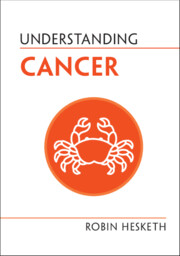Book contents
- Understanding Cancer
- Series page
- Understanding Cancer
- Copyright page
- Reviews
- Dedication
- Contents
- Foreword
- Preface
- Acknowledgements
- Gene Names
- 1 Painting a Clear Picture
- 2 Ancient History
- 3 Counting Cancer
- 4 From DNA to Protein
- 5 What Is a Cell?
- 6 Mutations
- 7 Causes of Cancer That Can be Controlled
- 8 Causes of Cancer That Are Difficult to Control, Accidents … and Other Things
- 9 Treating Cancer by Chemotherapy
- 10 The Road to Utopia?
- Concluding Remarks
- Summary of Common Misunderstandings
- References
- Figure Credits
- Index
5 - What Is a Cell?
Published online by Cambridge University Press: 17 May 2022
- Understanding Cancer
- Series page
- Understanding Cancer
- Copyright page
- Reviews
- Dedication
- Contents
- Foreword
- Preface
- Acknowledgements
- Gene Names
- 1 Painting a Clear Picture
- 2 Ancient History
- 3 Counting Cancer
- 4 From DNA to Protein
- 5 What Is a Cell?
- 6 Mutations
- 7 Causes of Cancer That Can be Controlled
- 8 Causes of Cancer That Are Difficult to Control, Accidents … and Other Things
- 9 Treating Cancer by Chemotherapy
- 10 The Road to Utopia?
- Concluding Remarks
- Summary of Common Misunderstandings
- References
- Figure Credits
- Index
Summary
We have already encountered the seventeenth-century scientific genius Robert Hooke giving mankind his first glimpse of the miniature world of cells. It seems likely that Micrographia, his book of illustrations, came into the hands of one Antonie van Leeuwenhoek, the proprietor of a drapery business in Delft in the province of South Holland. In his spare time Leeuwenhoek had taught himself how to handle glass and he became so skilled that he was able to make the first compound microscope – one using two lenses that could magnify objects several hundred times. He started to look at animal cells and, in 1677, became the first person to see single red blood cells and sperm cells. He went on to discover bacteria, thereby making himself the first microbiologist. Through these technical advances, Leeuwenhoek changed the world by enabling scientists to look at individual cells, setting us on the road to understanding what we now simply accept as a fact of life – that all animals and plants are clumps of cells. Few outside science would recognize Leeuwenhoek’s name today, which is slightly sad and somewhat ironic, given that his lifelong friend, the artist Vermeer, is world-famous.
- Type
- Chapter
- Information
- Understanding Cancer , pp. 64 - 75Publisher: Cambridge University PressPrint publication year: 2022

